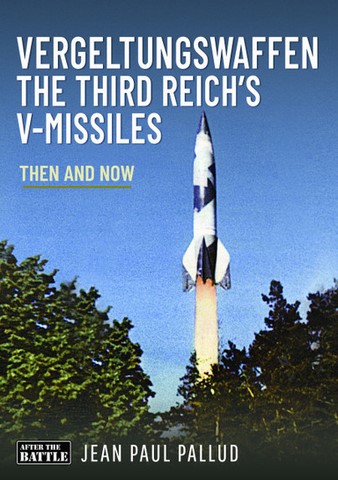264131 - VERGELTUNGSWAFFEN: THE THIRD REICH'S V-MISSILES Then & Now

Compiled by Jean Paul Pallud
Whether it is their innovative technical development or the Nazi propaganda harping them as revolutionary wonder weapons, readers interested in World War II find the research on 'German secret weapons' very interesting.
The V1, a flying bomb we would now call a cruise missile, opened in June 1944 and soon dozens of them were hitting England day and night. Churchill was so worried that he issued a memorandum proposing to drop poison gas on German cities. To strengthen the faith of the German people in the final victory, despite an increasingly desperate military situation, Nazi propaganda gave the name to this new weapon, V1 for Vergeltungswaffe 1, weapon of revenge number 1.
The first V2s, a large liquid-fuelled rocket, were fired against Paris and London on September 8.
The V1s and V2s, but also jet engines, were produced by slave workers in the underground factory of Mittelwerk. Inmates from nearby Dora concentration camps provided the labour force, the usual gruesome methods were employed, and over 20,000 of the forced laborers of the Mittelwerk perished. The SS finally seized power not onlye of the production of V-Weapons but also of their operational command.
The last months of World War II, when Germany was on the defensive on all fronts and desperately looking for 'wonder weapons', saw a number of ineffective, albeit innovative, technical developments. Among them were the HDP and the Rheinbote, the third and fourth V-Weapons, which were launched into battle in small numbers.
V-weapons were indeed inventive weapon concepts, but it must be remembered that Nazi Germany failed to realize that the real super-weapon was going to come from nuclear technology. The only real superweapon of World War II, the atomic bomb, was developed by the Western Allies.
The Allied powers had recognized the technical potential of the V2s and to learn German technique of launching long-range rockets, an Operation 'Backfire' was conducted in the summer of 1945 with captured German personnel supervised by British technical experts. Three V2s were launched in October. The United States wasted no time in acquiring 120 top rocket scientist Germans and the first test of a V2 on American soil took place on March 3, 1946. The Russians also captured German rocket technicians who quickly resumed their work in Russia.
AUTHOR:
Jean Paul Pallud was born in Annecy in south-eastern France and graduated from Grenoble University as a Physicist Engineer. Author of several books in English and French, he is also a long-time contributor to After the Battle. Married to Marie-François he lives near his home town in the picturesque Alps.
| Format | Hardback |
| Pages | 288 |
| Publication Date | Available |
| Pictures |
20 colour, 280 mono illustrations |
| Width (mm) | 172 |
| Height (mm) | 246 |
| Dust Jacket | Yes |
| ISBN | 978-1-03610-138-1 |
| Price |
£29.99 |

